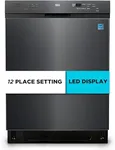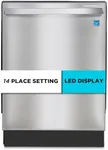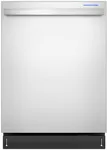Buying Guide for the Best Built In Dishwashers
Choosing the right built-in dishwasher can make your kitchen chores much easier and more efficient. When selecting a dishwasher, it's important to consider various specifications that will impact its performance, capacity, and convenience. Understanding these key specs will help you find a model that best fits your needs and lifestyle.CapacityCapacity refers to the number of place settings a dishwasher can handle in one cycle. This is important because it determines how much you can wash at once. Dishwashers typically range from 8 to 16 place settings. For smaller households or those who don't cook often, a lower capacity (8-10 place settings) might be sufficient. Larger families or those who entertain frequently may benefit from a higher capacity (12-16 place settings). Consider your daily dishwashing needs and choose a capacity that matches your usage.
Energy EfficiencyEnergy efficiency indicates how much electricity and water the dishwasher uses. This is important for both environmental impact and your utility bills. Dishwashers are rated by the Energy Star program, with more stars indicating higher efficiency. Look for models with high energy efficiency ratings to save on energy costs and reduce your carbon footprint. If you use your dishwasher frequently, investing in an energy-efficient model can lead to significant savings over time.
Noise LevelNoise level measures how loud the dishwasher is during operation, typically in decibels (dB). This is important if your kitchen is near living areas or if you run the dishwasher at night. Dishwashers can range from around 40 dB (very quiet) to over 60 dB (quite loud). For a quieter home environment, look for models with a noise level of 45 dB or lower. If noise isn't a major concern for you, a higher noise level might be acceptable, especially if it comes with other desirable features.
Wash Cycles and OptionsWash cycles and options refer to the different settings available for cleaning your dishes. This is important for handling various types of loads and levels of dirtiness. Common cycles include normal, heavy, quick, and eco. Some dishwashers also offer specialized cycles like sanitize, delicate, or half-load. Consider what types of dishes you wash most often and choose a dishwasher with cycles that match your needs. For example, if you frequently wash heavily soiled pots and pans, a heavy cycle is essential.
Drying PerformanceDrying performance indicates how well the dishwasher dries your dishes after washing. This is important to avoid having to hand-dry items after a cycle. Dishwashers use different drying methods, such as heated drying, fan-assisted drying, or condensation drying. Heated drying is effective but uses more energy, while condensation drying is more energy-efficient but may not be as thorough. Choose a drying method that balances your preference for dry dishes with your energy efficiency goals.
Interior MaterialInterior material refers to the material used inside the dishwasher, typically stainless steel or plastic. This is important for durability and maintenance. Stainless steel interiors are more durable, resist stains and odors, and can handle higher temperatures, which can improve drying performance. Plastic interiors are generally less expensive but may not last as long and can retain odors. If you want a long-lasting, low-maintenance dishwasher, opt for a stainless steel interior.
Rack ConfigurationRack configuration describes the layout and adjustability of the dishwasher racks. This is important for accommodating different types and sizes of dishes. Some dishwashers offer adjustable or removable racks, foldable tines, and specialized holders for items like wine glasses or cutlery. Consider the types of dishes you use most often and choose a rack configuration that provides flexibility and convenience. If you frequently wash large or awkwardly shaped items, look for models with customizable rack options.

















